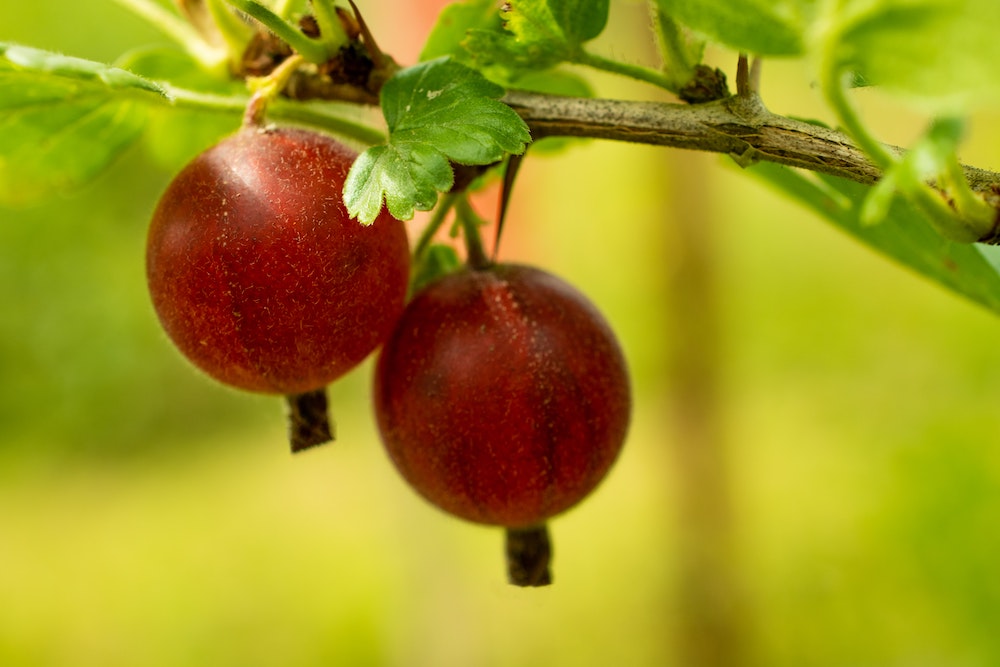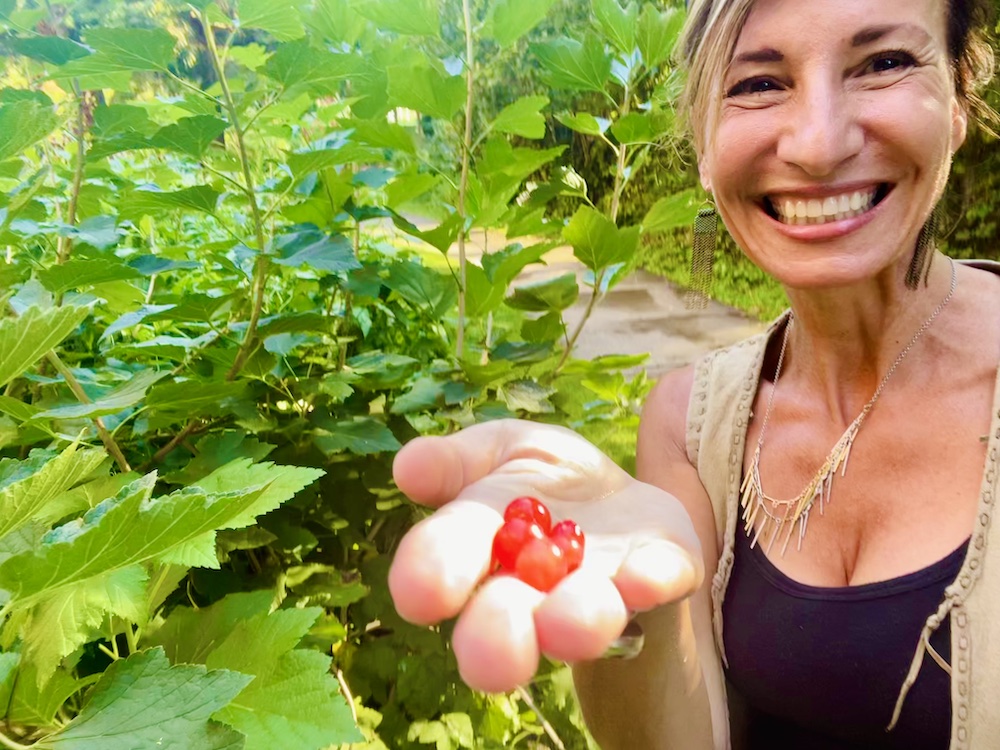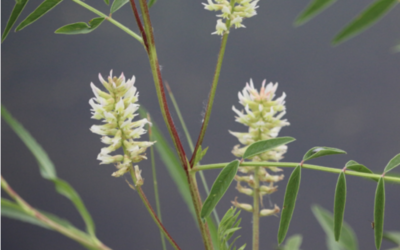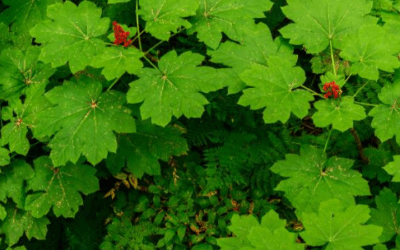A Small But Mighty Berry For Health
Even though gooseberries are not a widely known fruit, if you would like to age gracefully, balance blood sugar, and boost brain and cardiovascular health, this is certainly one berry that you will want to get to know. Found throughout North America and Europe, as well as in North Africa and Western Asia, you may have come across it while on a hike in the woods or growing wild in a field. Many also cultivate this versatile plant for its fruit. Keep reading to learn more about why gooseberries should be part of your daily diet —recipe included!
Basic Identification
Shrubs may be upright, sprawling, or loosely spreading and can grow up to 1.6-5 ft. (0.5-1.5m) tall. There are over 50 species in the Ribes genus and all are edible. Common North American species include: American Gooseberry, R. hirtellum, Northern Gooseberry, R. cynosbati. European varieties include Ribes uva-crispa. All are related to black, red, and white currants. The fruit can range in color from green, yellowish-white, and pink to red or dark purple. The leaves are three-lobed with coarsely toothed edges and measure 0.5-5 inches (1.2-12.5cm) long. They are a grayish-green color and many times are covered with very fine hairs. Thorns grow at the base of the leaf stalks.
Where Does It Grow? Gooseberry is found in fields, woodland clearings, bogs, swamps, forests, and rocky heights.

Harvesting
Since the fruit does not all ripen at once, the season for gooseberries is quite long — beginning as early as June and ending as late as September. For fully ripe fruit, look for gooseberries that are soft when squeezed.
Edible Uses
The flavor of gooseberry ranges from tart to sweet. The slightly unripe fruit is excellent for making jams, pies, and sauces. Fully mature fruit can be eaten fresh. Any spines are removed by cooking. Gooseberry pairs well with fish, meat, and poultry, or eaten as dessert with cream. The fruit is the only edible part of the plant.
Recipe. Roasted Mackerel with Gooseberry Sauce. In a saucepan, combine 1 1⁄2 cup gooseberries, 1⁄2 tbsp. white wine vinegar, 3 tbsp. sugar, 1 finely chopped shallot, 4 tbsp. olive oil, 4 tbsp. water, salt, and ground black pepper. Simmer for 15-20 min. Place a whole, gutted, and cleaned mackerel on a sheet of aluminum foil and cover with gooseberry sauce. Fold over the foil’s edges and wrap up the fish tightly. Secure in another layer of aluminum foil. Roast for 5-8 min.
Medicinal Uses
Gooseberries are rich in vitamin C and antioxidants.4 The fruit is also a good source of vitamins B5, B6, and E, along with copper, manganese, and potassium.5 Because of their high antioxidant profile, gooseberries can help to reduce the effects of oxidative stress that leads to disease and premature aging. They may be helpful in reducing the risk of cancer, heart disease, type 2 diabetes, and degenerative neurological conditions.1,2,3 Gooseberries are an excellent source of soluble and insoluble fiber as well, which assists in controlling blood sugar, improving digestive motility, and lowering blood pressure, cholesterol, and the risk of chronic disease.

Here are my top 3 uses for gooseberries:
Protective for the brain. While appropriate levels of iron are necessary for a host of biological functions, if we accumulate too much of this mineral in our cells, it can lead to problems — particularly in the brain. Since the cells in the brain tend to store high levels of iron, they are more at risk for damage. Organic acids within the berry have been shown to block the accumulation of iron in the cells, thereby helping to reduce the development of Alzheimer’s.7,8 The antioxidant and phytonutrients found in gooseberries are neuroprotective and may help to prevent stroke and the lower the risk of other age-related brain diseases.
Blood sugar control. Several compounds within the fruit help with blood sugar regulation — including fiber and chlorogenic acid. Both help to slow carbohydrate absorption and reduce blood sugar spikes after a starchy meal. Additionally, studies have shown that gooseberry extract is an alpha-glucosidase inhibitor, which binds to enzymes in the small intestine and prevents them from moving sugar into the bloodstream from the gut.6
Anticancer properties. Since gooseberries are high in antioxidants and polyphenols, research has found that they may help to reduce the risk of certain forms of cancer, such as those of the colon, pancreas, and breast.9 Of particular interest are the anthocyanins, folate, phenolic compounds, and vitamins C and E found in the berry, as they prevent and repair oxidative damage and inflammation — both of which are associated with the development of cancer.6
A Foraging Guide Like No Other
Interested in learning more about gooseberries and over 400 medicinal and edible wild foods? My book, The Forager’s Guide to Wild Foods: Edible Plants, Lichens, Mushrooms, and Seaweeds, is for you! This wild food guide covers a wide-range of plants across North America.
Each entry has an introduction, a range map, edible uses, common medicinal uses, poisonous look-alikes, a description of the flowers and leaves for ID, excellent color photos, harvesting instructions, and a simple recipe.
Wishing you many days of abundant and happy foraging!
Nicole Apelian
References
- Nile, S. H., & Park, S. W. (2014). Edible berries: bioactive components and their effect on human health. Nutrition (Burbank, Los Angeles County, Calif.), 30(2), 134–144. https://doi.org/10.1016/j.nut.2013.04.007
- Zhang, Y. J., Gan, R. Y., Li, S., Zhou, Y., Li, A. N., Xu, D. P., & Li, H. B. (2015). Antioxidant Phytochemicals for the Prevention and Treatment of Chronic Diseases. Molecules (Basel, Switzerland), 20(12), 21138–21156. https://doi.org/10.3390/molecules201219753
- Williamson G. (2017). The role of polyphenols in modern nutrition. Nutrition bulletin, 42(3), 226–235. https://doi.org/10.1111/nbu.12278
- Orsavová, J., Hlaváčová, I., Mlček, J., Snopek, L., & Mišurcová, L. (2019). Contribution of phenolic compounds, ascorbic acid and vitamin E to antioxidant activity of currant (Ribes L.) and gooseberry (Ribes uva-crispa L.) fruits. Food chemistry, 284, 323–333. https://doi.org/10.1016/j.foodchem.2019.01.072
- “Gooseberries, raw” USDA FoodData Central, April 1, 2019. Retrieved on March 14, 2023 from, https://fdc.nal.usda.gov/fdc-app.html#/food-details/173030/nutrients
- DA SILVA PINTO, M., KWON, Y.-I., APOSTOLIDIS, E., LAJOLO, F.M., GENOVESE, M.I. and SHETTY, K. (2010), EVALUATION OF RED CURRANTS (RIBES RUBRUM L.), BLACK CURRANTS (RIBES NIGRUM L.), RED AND GREEN GOOSEBERRIES (RIBES UVA-CRISPA) FOR POTENTIAL MANAGEMENT OF TYPE 2 DIABETES AND HYPERTENSION USING IN VITRO MODELS. Journal of Food Biochemistry, 34: 639-660. https://doi.org/10.1111/j.1745-4514.2009.00305.x
- Stanislaw Pluta,Gooseberry—Ribes uva-crispa, sin. R. grossularia L, Editor(s): Sueli Rodrigues, Ebenezer de Oliveira Silva, Edy Sousa de Brito, Exotic Fruits, Academic Press, 2018, Pages 211-218, ISBN 9780128031384, https://doi.org/10.1016/B978-0-12-803138-4.00027-7.
- Keenan, B. M., Robinson, S. R., & Bishop, G. M. (2010). Effects of carboxylic acids on the uptake of non-transferrin-bound iron by astrocytes. Neurochemistry international, 56(6-7), 843–849. https://doi.org/10.1016/j.neuint.2010.03.009Nile, S. H., & Park, S. W. (2014). Edible berries: bioactive components and their effect on human health. Nutrition (Burbank, Los Angeles County, Calif.), 30(2), 134–144. https://doi.org/10.1016/j.nut.2013.04.007





